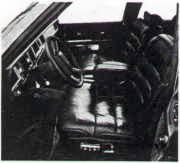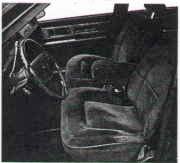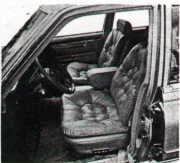|
|
|
|
| Tested car. Four-door LS, $12,854. Standard equipment includes fuel-injected five-liter V8, automatic overdrive transmission, power steering, power brakes, reclining front seats, power windows, stereo radio, and tinted glass. Major options on our car: air-conditioning, power door locks, premium stereo, rear-window defroster, tilt steering wheel, speed control, power driver's seat, and leather upholstery. Total list price: $16,617, including destination charge. | Tested car. Four-door, $14,331. Standard equipment includes three-liter V6 engine, automatic overdrive transmission, power steering, power brakes, air-conditioning, tinted glass, stereo radio, power driver's seat, and power windows. Major options on our car: fuel-injected 3.8-liter V6 engine, cruise control, tilt steering column, and rear-window defroster. Total list price: $15, 636, including destination charge. | Tested car. Four-door, $14,205. Standard equipment includes 5.2-liter V8, automatic transmission, power steering, power brakes, air-conditioning, tinted glass, rear-window defroster, AM radio, and power windows. Major options on our car: power door locks, power driver's seat, leather upholstery, speed control, tilt steering coulmn, stereo radio with premium speakers and cassette tape player. Total list price: $16,892, including destination charge. |
| Other styles. Two-door, $12,240; two-door LS, $12,789. Four-door, $12,305. Station wagon Colony Park, $12,511. The Mercury Grand Marquis and the Ford LTD Crown Victoria are twins and are available in the same body styles. | Other Styles. Two-door, $14,149; T-type, $15,386; Park Avenue, $16,080. Four-door T-type, $15,568; Park Avenue, $16,240. The Oldsmobile Ninety Eight Regency and Regency Brougham are similar. | Other styles. None. The Dodge Diplomat and the Plymouth Gran Fury are essentially similar to the Fifth Avenue, but they offer far fewer luxury appointments. |
| Starting/running. (excellent)
Flawless at all times. |
Starting/running. (excellent)
Started and ran well at all times. |
Starting/running. (excellent)
Always started easily and ran well. |
| Acceleration. (excellent)
Responsive, with ample reserve power. |
Acceleration. (better than average) Ample power. Throttle response was oversensitive on slippery pavement; the wheels could spin too easily-a potential problem in winter. | Acceleration. (better than average) Plenty of power. The engine knocked during moderate acceleration. Premium gasoline-not required, but recommended by the owner's manual- would lessen the problem. |
| Transmission. (better than average) Smooth most of the time, but shifts into and out of overdrive were annoyingly frequent. | Transmission. (better than average) Usually smooth, but any acceleration in high gear caused a shift out of lock-up. The constant back-and-forth shifting became annoying. | Transmission. (excellent)
Very smooth shifting. A lock-up feature reduces engine noise and saves fuel at highway speeds. |
| Economy. (worse than average) Typical for a car of this size, about 17 mpg overall. Theoretically, the 18-gallon tank allows about 350 miles between fill-ups. That's an inconveniently short range for a road cruiser like this. And it's made worse by a fuel gauge so inaccurate it signals nearly empty when the tank is one-third full. | Economy. (average) The Buick is lighter than the two other cars and it's engine is smaller, so it uses less fuel. It delivered about 21 mpg overall. | Economy. (worse than average) Overall mileage was comparable to that of the Mercury-about 17 mpg. The Chrysler's cruising range was as short, too, but at least the fuel gauge didn't intimidate drivers into too-frequent fill-ups. |
| Routine handling. (average) The power steering felt numb, and the car's response to it's steering was sluggish. But the car handled reasonably well. | Routine handling. (average) Disappointing. Because the Buick is smaller, lighter, and more modern in design, we expected it to handle better than it did. The car responded a little less sluggishly than the Mercury, but the power steering gave little feedback. The soft front suspension bounded over bumps in turns, making directional control feel uncertain. The rear wheels tended to move to the side, sometimes severely, over sharp bumps. | Routine handling. (worse than average) The car didn't track as straight as it should. It tended to wander on freeways and required frequent small steering corrections. The power steering gave drivers a bit more road feel than in the other cars. |
| Emergency handling. (average) The Mercury couldn't swerve back and forth on our pylon course at as high a speed as most other cars. The car's bulk and vague steering were part of the problem. A greater part of the problem, however, was temporary loss of power-steering assist during abrupt changes in direction. The sharp increase in steering effort was disconcerning. However, in hard turns around the test track, the Grand Marquis felt remarkably steady and responsive for such a large car. | Emergency handling. (average) The Buick responded sluggishly in the abrupt accident-avoidance maneuvers simulated by our pylon course; it tended to plow straight ahead when we wanted it to turn. The numb power steering made the car hard to control precisely. Although the car felt sloppy, it handled the course safely at respectably high speeds. In hard turns at the test track, the steering felt vague and the car was a bit unsteady, but always controllable. | Emergency handling. (better than average) The Chrysler handled distinctly better than the other cars in emergency maneuvers. It negotiated the pylon course steadily and predictably, and at higher speeds than the Mercury and the Buick. It also felt steady, though a little sloppy, in hard turns at the test track. |
| Braking. (better than average) Nearly perfect. The rear brakes locked during very hard stops, but the car didn't swerve. | Braking. (better than average) The brakes were a bit too sensitive in normal driving. Short stops made the car's nose dive. | Braking. (average) In very short stops, one rear wheel or front brake usually locked, making the car weave. |
| Ride. (excellent) Best-riding car we've tested in recent years. The new gas-pressurized shock absorbers made the ride even better than in the 1983 Ford LTD Crown Victoria we tested. (This year's Crown Victoria has gas-pressurized shocks, too.) A large car should ride as well with six passengers and luggage as with one or two passengers. The Mercury did. | Ride. (better than average) Very smooth on good roads, but there was pitching and rocking on secondary roads. Ride comfort was satisfactory except over large bumps; the car seemed to plow into them, bottoming it's front suspension. The largest bumps made the front end bound up and down. A full load of six passengers and luggage tamed those motions, but then the rear suspension bottomed. | Ride. (average) The car rode well on smooth roads but failed to mask the effects of rough roads. It bounded and snapped, occasionally bottoming it's front suspension. The rear suspension bottomed frequently-and hard-when the car carried a full load of six passengers and luggage. Rear passengers suffered particularly when the car bottomed. |
| Noise. (excellent) Impressively quiet. | Noise. (better than average) Coarse pavement significantly increased the noise level, unusual in a large GM car. | Noise. (average) Disappointingly noisy at highway speeds. |
| Driving position. (excellent) One small complaint: The accelerator was too far left and, for short drivers, a rather long stretch. We liked the optional power driver's seat, which adjusted six ways to suit assorted physiques. You can set the optional tilt steering wheel at various angles, but you can't raise and lower it like a tilt steering column. | Driving position. (better than average) The Buick's accelerator pedal, like the Mercury's, was too far left. The power-operated driver's seat can be adjusted six ways, and the optional tilt steering column can be adjusted up or down for tailor-made driver comfort. The thin, hard steering wheel was unpleasant to hold. | Driving position. (better than average) The Chrysler's power-operated driver's seat adjusts six ways, but the seatback can't recline. (You may have to make seat adjustments with the door open; there's barely enough room for a hand between the door and the side of the seat, where the controls are.) Most drivers found the steering wheel too close. |
| Front seating. (excellent) The bench seat is split in half, and the angle of each seatback can be adjusted in steps for some much-needed lower-back support. Each seat has it's own fold-down armrest at the car's center. That's nice for two, but when three people ride in front, the center occupant gets the folded armrests for a seatback. In addition, that person sits on the hard, contoured edges of the separate seat cushions. All in all, the center position is tolerable only for short rides. The tilt steering wheel made it easy for drivers to get in and out. | Front seating. (excellent) The front seat is split: 60 percent for the driver, 40 percent for the passenger. The six-way adjustment of the driver's seat doesn't include a separate angle adjustment for the seatback. You must tip the entire seat. The passenger's seat doesn't recline at all. Lower-back support was weak, and pillow-like padding high on the seatback made occupants slump forward. Three average-sized men had room enough. The nearly flat floor gave adequate leg room. Access to the front seat was easy. | Front seating. (excellent) The bench seat is split 60/40 and has a fold-down armrest in the center. The passenger's seatback can be reclined in steps for more lower back support. THe soft, pillowy padding of the seats is shaped to provide side and thigh support for two occupants. When three rode abreast, the padding twisted the driver and the outboard passenger inward. And the slippery leather upholstery (an option) let them slide toward the center, squeezing the middle man. The center passenger was further cramped by a large transmission tunnel. |
 |
 |
 |
| Rear seating. (better than average) The rear seat provided adequate thigh support but not enough side or lower-back support. It felt a bit too firm in the center. Three average sized men had ample room. | Rear seating. (better than average) The generous seat cushion provided good thigh support. Contoured cushion provided good thigh support. Contoured cushions cradled two occupants to provide comfortable side support, but lower back support was wanting. Room for three adults was ample, but the contouring of the seat tipped outboard passengers inward, and the folded armrest pressed into the center passenger's back. All three passengers are likely to become uncomfortable on a long trip. The curve of the upper part of the door opening interfered a bit with access. | Rear seating. (worse than average) Seating in the rear belies the Chrysler's claim to a large-car status. There's just enough head and knee room for six-foot-tall occupants and just enough width for three average-sized men. The seat lacked sufficient thigh and lower-back support. As in the front seat, the pillowy cushions provided good side support for two passengers but compromised comfort for three. Fairly tight foot clearance hampered access to the rear. |